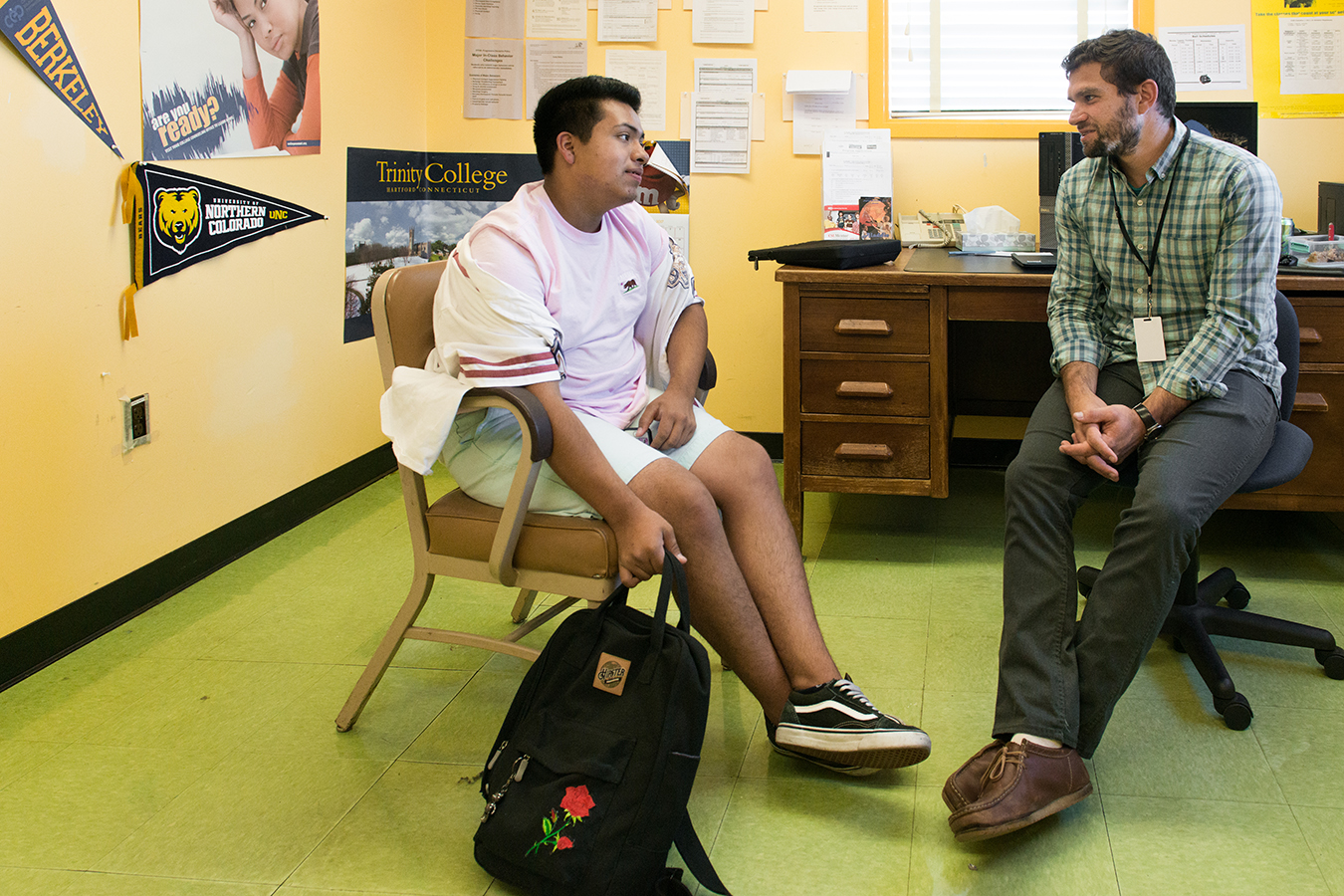Gerardo Alejandrez (left) meets with counselor Erich Roberts at Oakland Technical High School in September 2017. Gerardo used to throw chairs, hit his classmates and curse at his teachers before enrolling at Oakland Tech. “It was terrible times for me,” the teen says. (Heidi de Marco/KHN)
OAKLAND, Calif. — Gerardo Alejandrez used to punch classmates, throw chairs and curse at his teachers, conduct that forced him to switch from school to school. “I had a lot of anger issues,” the 16-year-old said recently.
Then Gerardo entered a class at Oakland Technical High School for students who have mental health or behavior issues. In that classroom, the teacher gets support from Erich Roberts, a psychiatric social worker assigned to the group. Oakland Unified School District bills Medicaid, the nation’s insurance program for low-income residents, for Roberts’ services.
Those payments officially cover the time he spends — in and out of the classroom — providing therapy and other assistance for nine Medicaid-covered youths as well as meeting with their family members. Roberts’ presence in the classroom is also an asset for the teacher and four other kids in the class who are not on government insurance. Many of the students in the class would likely drop out without the extra help, Roberts said.
Medicaid, created in 1965 to provide health insurance to the poor, now functions as a lifeline for millions of American students such as Gerardo — whose grades have improved and who wants to become a fashion designer — as well as hundreds of school districts across the country like Oakland Unified. The public insurance program has evolved so that it now finances myriad education-related services, including transportation for kids with disabilities, school clinics and counseling for children from turbulent backgrounds. Medicaid funds are now woven into the nation’s educational system.
But as Congress seeks to cut federal health spending, the use of Medicaid dollars in schools could come under new scrutiny. Critics question whether schools are the best entities to provide all the services they now do, and if the educational system has become too reliant on the health program. Educators and advocates counter that schools are the opportune place to address health-related issues and that federal law requires them to provide such benefits. And, they say, if Medicaid doesn’t pay, who will?
With a Republican administration vowing to trim Medicaid, Kaiser Health News is examining how the U.S. has evolved into a “Medicaid Nation,” where huge swaths of Americans rely on the program, directly and indirectly, often unknowingly. Medicaid’s role in schools is a telling example.
Medicaid spends only $4 billion of its $400 billion annual budget in schools — a “very small portion of the pie,” said Jessica Schubel, a senior policy analyst at the bipartisan Center on Budget and Policy Priorities. But for the school districts providing an array of services that have quietly become vital to students and families, losing this funding source would be immense, she said, “a big deal.”
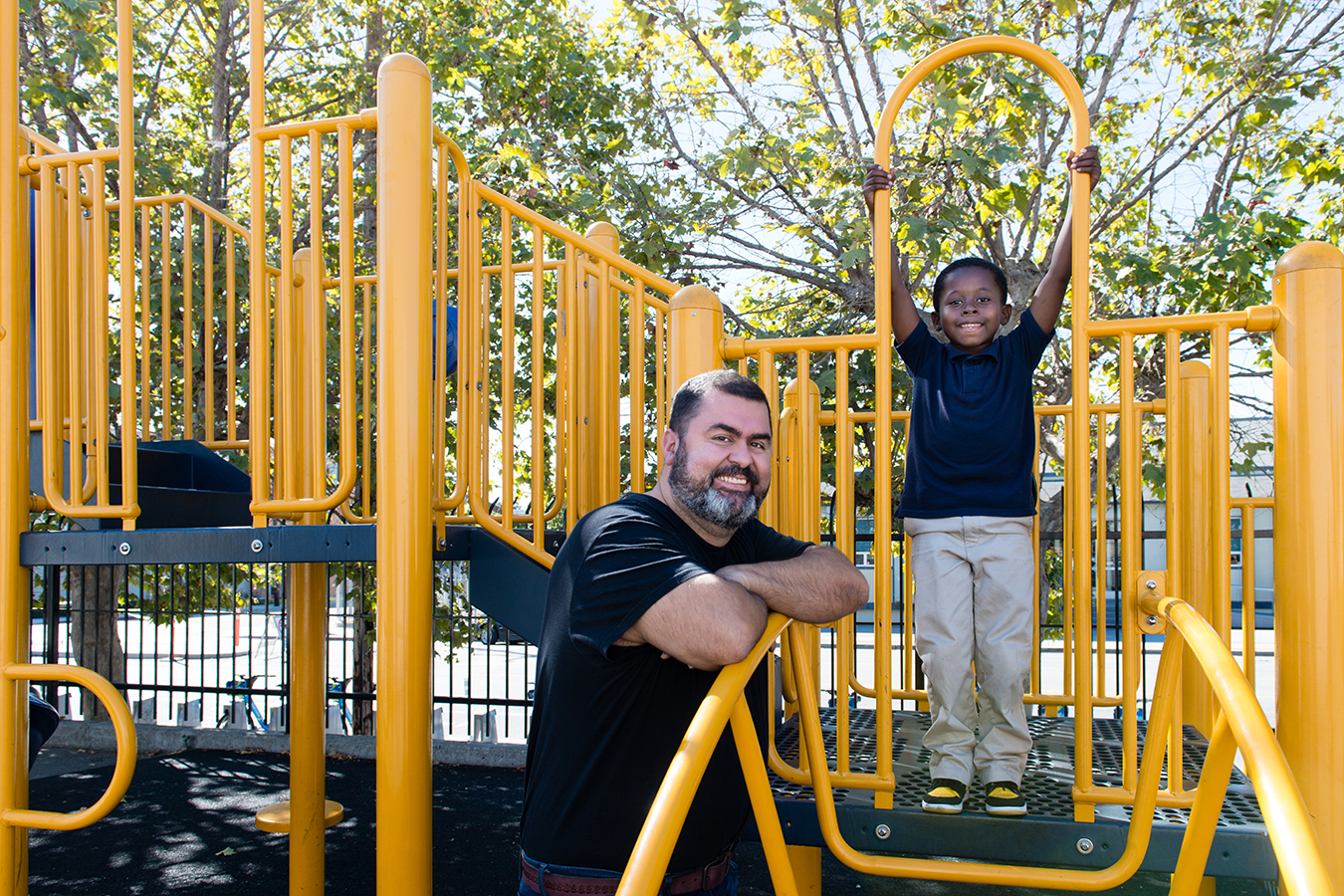
Rodney Davis (right) became anxious and stopped wanting to go to school until he started seeing JP De Oliveira, a clinical counselor with the nonprofit East Bay Agency for Children. Medicaid pays for De Oliveira’s work with students at Hoover Elementary School in Oakland, Calif. (Heidi de Marco/KHN)
An Expanded Purview
The exact nature of the consequences would depend largely on the state and school districts, as jurisdictions deploy Medicaid funds differently. Since states must contribute a portion of total Medicaid funding to the federal allocation, the amount of money available for school district spending is in part determined by statehouse politics.
Generally, the federal program can help districts provide a variety of services, staff and equipment for their students. Although not all districts tap into funding, Medicaid will reimburse districts for in-school vision and hearing exams, occupational therapy for special-education students, even diabetes and asthma management. It covers wheelchairs and other medical devices so a student can attend class. In Oakland Unified School District and others around the nation, Medicaid also supports mental health services.
In 2017, a survey by the School Superintendents Association found that 68 percent of superintendents said Medicaid dollars funded school nurses, counselors and other health staff members. More than half of superintendents said they have worked to expand the number of students enrolled in Medicaid, which can increase revenue to the school districts. The funds also enable districts to pay staff salaries like Roberts’, buy medical equipment and generally bolster their education budgets, Schubel said.
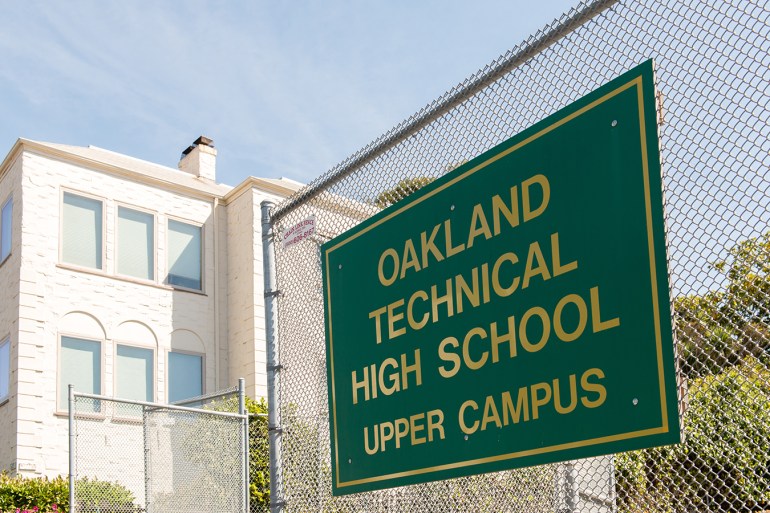
Medicaid provides mental health services at Oakland Technical High School in Oakland, Calif. (Heidi de Marco/KHN)

Artwork portraying children’s feelings hangs in the office of JP De Oliveira, a clinical counselor at Hoover Elementary School in Oakland. (Heidi de Marco/KHN)
But some critics of Medicaid, notably political conservatives, question how funds flow into school districts and whether educators have wrongly plumbed the program to cover budget shortfalls. They argue that because the districts already receive other sources of federal funding for special-education and health services in schools, they don’t need federal Medicaid dollars to pay for them.
Lindsey Burke, director of the Center for Education Policy for the Heritage Foundation, a conservative think tank, argues that Medicaid expenses overall are growing too quickly. She said changes are needed to allow states and districts more flexibility and to reward “sound choices” about what to deliver using Medicaid money.
“Medicaid requires that poor children’s health care be covered, but does not prescribe that such coverage be delivered by school districts,” Burke said.
In the past, the government penalized some school districts for straying far afield from intended purposes. Ten years ago, federal investigators uncovered improper billing for school-based Medicaid services, and cases of waste and fraud in Texas, Massachusetts and New York. Dollars meant for medical care were used for children’s transportation or school officials’ salaries or benefits. Texas, in particular, was found in 2007 to have submitted close to 300 incorrectly coded claims, resulting in nearly $19 million of federal payments for costs not allowed under Medicaid’s in-school services program.
Schubel of the Center on Budget and Policy Priorities, who has studied Medicaid in schools, emphasized that school administrations “are in the business of providing education — they are not in the business of providing medical services.”
Filling Gaps Left By The Feds
The increasing reliance by schools on Medicaid in many states is in some ways a byproduct of federal mandates to broaden educational services and a lack of specific funds to pay for them.
In 1975, Congress passed the Individuals with Disabilities Education Act (IDEA), which gave students with disabilities the right to a free education adapted to their needs. The law stipulates that Congress can pay up to 40 percent of the average cost per student for every child receiving special education. However, payments have never met that threshold.
Medicaid helps bridge the gap.
Among the students served by Medicaid in the classroom is Michael Walt, a 10-year-old with Williams syndrome, a genetic abnormality that causes heart problems and severe developmental delays. His school, Forestdale Elementary in Springfield, Va., provides a team of speech and occupational therapists to improve Michael’s physical and intellectual abilities.

Michael Walt, a pupil at Forestdale Elementary School in Alexandria, Va., was diagnosed with attention deficit hyperactivity disorder, autism and Williams syndrome, a condition linked to intellectual disabilities and heart conditions. Medicaid provided access to a team of therapists who taught him to walk, talk and hold utensils. (Heidi de Marco/KHN)
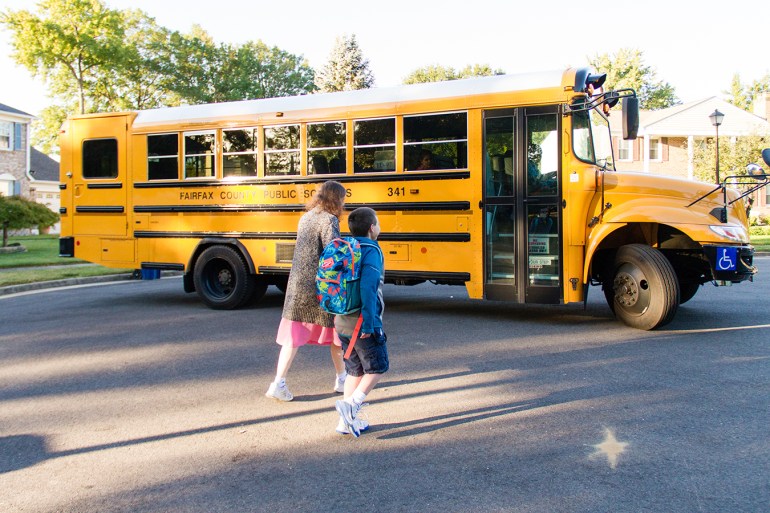
Lara Walt walks son Michael to the school bus in Alexandria, Va., on Oct. 4, 2017. Michael is one of over 25,700 students expected to receive special-education services in Fairfax County Public Schools this academic year. (Heidi de Marco/KHN)
Medicaid contributes $1.5 million a year on average to help pay for health services and therapy, said Fairfax County Public Schools spokesman John Torre. Their schools bill Medicaid for services including physical and occupational therapy, psychological counseling and speech-language assistance. It also pays for specialized transportation for students with disabilities, which Michael uses nearly every morning.
His mother, Lara Walt, an attorney, said services offered at school have improved Michael’s speech, gait and motor skills. He can now eat oatmeal with a spoon. Though her son may never live independently, she said, without Medicaid funds supporting special-education services, “he’d be in a much worse space.”
Across the country, JP De Oliveira, a professional clinical counselor with the Oakland-based East Bay Agency for Children, works at Hoover Elementary School in Oakland with students who are in Medi-Cal and have diagnoses that qualify them for counseling. His time with those kids is billed to Medi-Cal.
One of the students, 7-year-old Rodney Davis, is an outgoing child who became anxious last year and stopped wanting to go to school. Oliveira counsels Rodney, plays games with him and leads him in breathing exercises. “He really needs that reassurance … that everything is going to be OK,” Oliveira said.
Different States, Different Spending
While some California counties in and of themselves deploy millions of Medicaid dollars each year in classrooms, some entire states deploy little — or none. Much is unknown about exactly how Medicaid funds are spent in schools. “There is just not very good documentation of what policies states and locals have and how much they are using it,” said Nora Gordon, an associate professor at Georgetown University’s McCourt School of Public Policy.
Los Angeles Unified School District, which has a total budget of $7.5 billion and serves about 750,000 children, each year receives more than $20 million in funding from Medi-Cal, the name of its Medicaid program. The money helps pay for medical screenings, specialized equipment and health services for students at medical and mental health clinics. It is also used to enroll students and their families in health insurance plans under the Affordable Care Act.
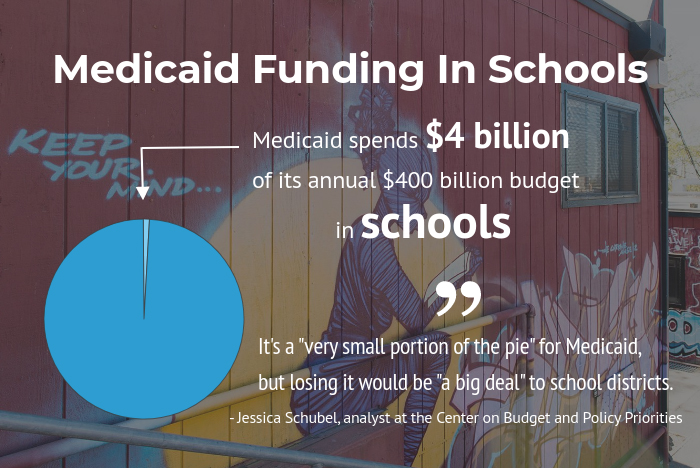
The district has nurses to serve each school, including 12 positions that are fully funded by Medi-Cal. The nurses provide a range of services, such as immunizations and asthma treatment.
In contrast, Wyoming does not bill Medicaid for any school-based health services. Instead, its state Department of Education reimburses school districts to cover special-education services. However, schools can use federal funds available through a separate federal funding stream — IDEA — to pay for additional resources like assistive technology, supplies and some staffing, said Brent Bacon, the department’s chief academic officer. These can range from a pencil grip to hiring a job coach to help students transition out of high school.
Bacon did not give a specific reason why Wyoming does not use Medicaid funding for special-education services. Dallas Myers, director of special education for Fremont County School District 1 in central Wyoming, said these federal dollars may complicate students’ ability to access these services.
“If you use Medicaid, you cap that service at a certain allowable fee,” he said. “And we couldn’t begin to get those professional staff people to serve our kids in a rural state like Wyoming if Medicaid came into the state.”
The federal and state share of payments varies, depending on how states prioritize such funding or bill Medicaid. In 2015, California covered about half of nearly $180 million in Medi-Cal funding for school-based services. Across Virginia, Medicaid payments for school-based health services totaled $58.8 million in 2015, of which nearly half came from the state’s coffers.
Tom Smith, a legislative liaison for the Virginia Association of School Superintendents, said the loss of federal Medicaid dollars could force school districts in Virginia and elsewhere to cut other services or dip into state and local funds that will translate into cuts in other sections of the budget, like infrastructure. “Everyone will feel the pain in one way or another,” he said.
KFF Health News' coverage of these topics is supported by Blue Shield of California Foundation and Heising-Simons Foundation



